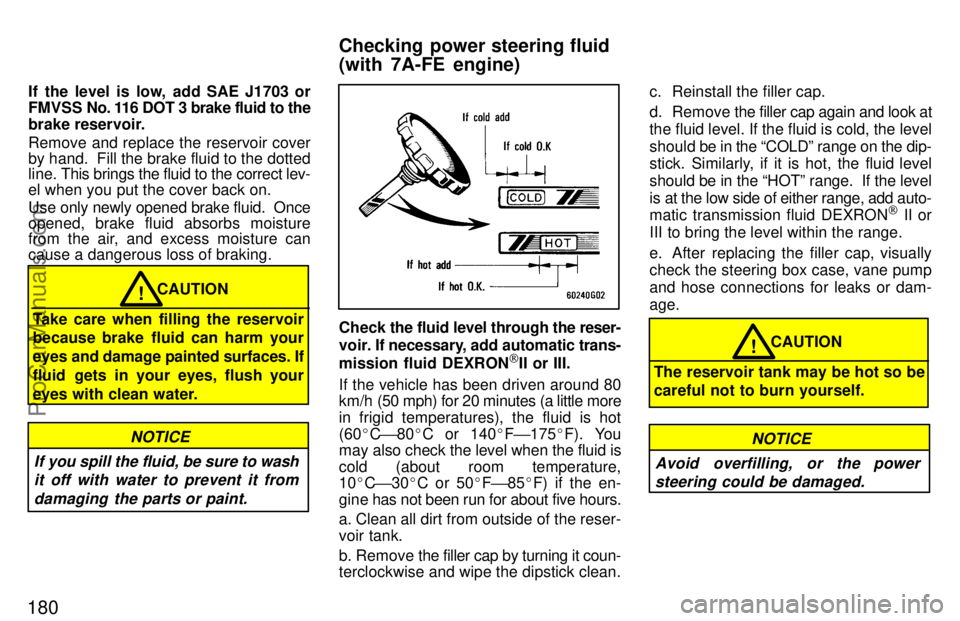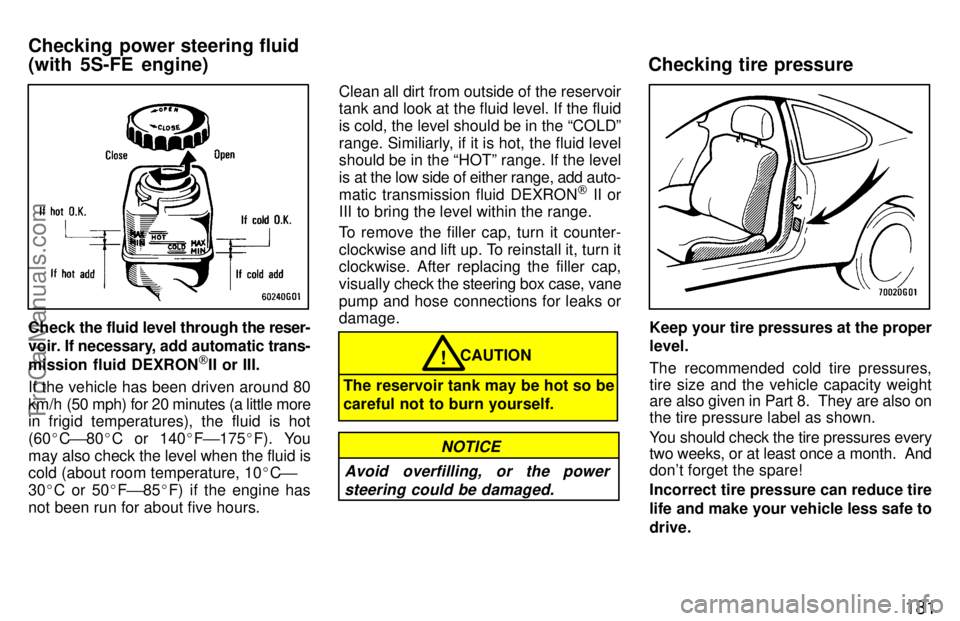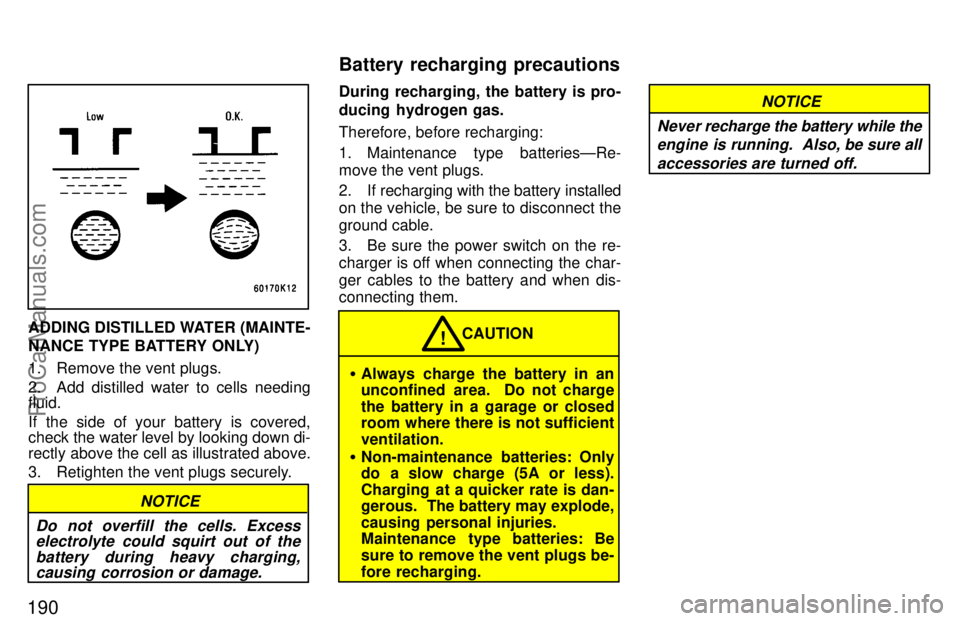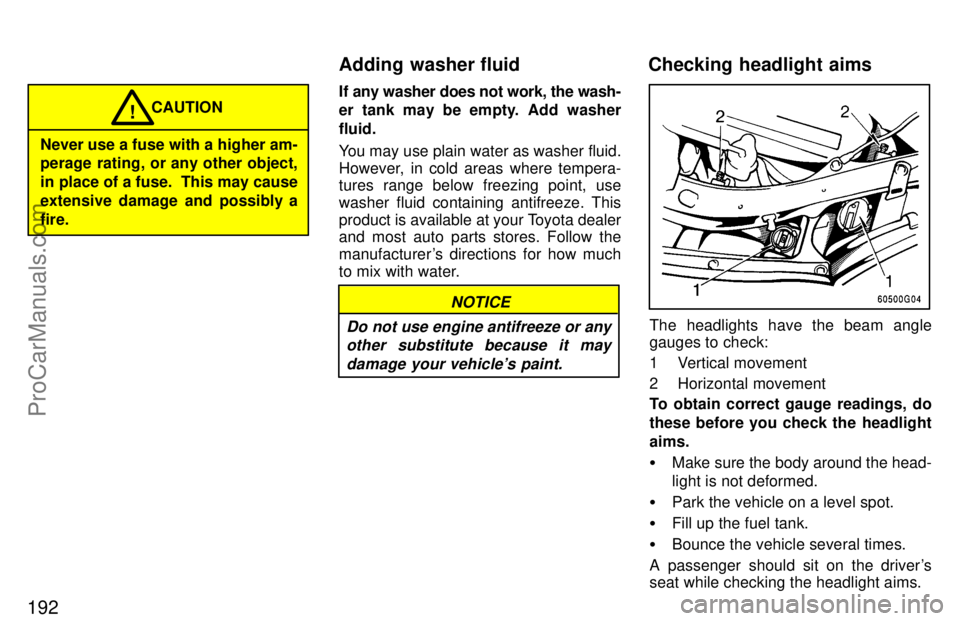Page 186 of 218

180
If the level is low, add SAE J1703 or
FMVSS No. 116 DOT 3 brake fluid to the
brake reservoir.
Remove and replace the reservoir cover
by hand. Fill the brake fluid to the dotted
line. This brings the fluid to the correct lev-
el when you put the cover back on.
Use only newly opened brake fluid. Once
opened, brake fluid absorbs moisture
from the air, and excess moisture can
cause a dangerous loss of braking.
CAUTION
Take care when filling the reservoir
because brake fluid can harm your
eyes and damage painted surfaces. If
fluid gets in your eyes, flush your
eyes with clean water.!
If you spill the fluid, be sure to wash it off with water to prevent it from
damaging the parts or paint.
NOTICE
Check the fluid level through the reser-
voir. If necessary, add automatic trans-
mission fluid DEXRON
[II or III.
If the vehicle has been driven around 80
km/h (50 mph) for 20 minutes (a little more
in frigid temperatures), the fluid is hot
(60 �C ' 80 �C or 140 �F ' 175 �F). You
may also check the level when the fluid is
cold (about room temperature,
10 �C ' 30 �C or 50 �F ' 85 �F) if the en-
gine has not been run for about five hours.
a. Clean all dirt from outside of the reser-
voir tank.
b. Remove the filler cap by turning it coun-
terclockwise and wipe the dipstick clean. c. Reinstall the filler cap.
d. Remove the filler cap again and look at
the fluid level. If the fluid is cold, the level
should be in the COLDº range on the dip-
stick. Similarly, if it is hot, the fluid level
should be in the HOTº range. If the level
is at the low side of either range, add auto-
matic transmission fluid DEXRON
[ II or
III to bring the level within the range.
e. After replacing the filler cap, visually
check the steering box case, vane pump
and hose connections for leaks or dam-
age.
CAUTION
The reservoir tank may be hot so be
careful not to burn yourself.!
Avoid overfilling, or the power steering could be damaged.
NOTICE
Checking power steering fluid
(with 7A-FE engine)
ProCarManuals.com
Page 187 of 218

181
Check the fluid level through the reser-
voir. If necessary, add automatic trans-
mission fluid DEXRON
[II or III.
If the vehicle has been driven around 80
km/h (50 mph) for 20 minutes (a little more
in frigid temperatures), the fluid is hot
(60 �C ' 80 �C or 140 �F ' 175 �F). You
may also check the level when the fluid is
cold (about room temperature, 10 �C '
30 �C or 50 �F ' 85 �F) if the engine has
not been run for about five hours. Clean all dirt from outside of the reservoir
tank and look at the fluid level. If the fluid
is cold, the level should be in the COLDº
range. Similiarly, if it is hot, the fluid level
should be in the HOTº range. If the level
is at the low side of either range, add auto-
matic transmission fluid DEXRON
[ II or
III to bring the level within the range.
To remove the filler cap, turn it counter-
clockwise and lift up. To reinstall it, turn it
clockwise. After replacing the filler cap,
visually check the steering box case, vane
pump and hose connections for leaks or
damage.
CAUTION
The reservoir tank may be hot so be
careful not to burn yourself.!
Avoid overfilling, or the power steering could be damaged.
NOTICE
Keep your tire pressures at the proper
level.
The recommended cold tire pressures,
tire size and the vehicle capacity weight
are also given in Part 8. They are also on
the tire pressure label as shown.
You should check the tire pressures every
two weeks, or at least once a month. And
don't forget the spare!
Incorrect tire pressure can reduce tire
life and make your vehicle less safe to
drive.
Checking power steering fluid
(with 5S-FE engine) Checking tire pressure
ProCarManuals.com
Page 194 of 218

188
Check the battery for corroded or
loose terminal connections, cracks, or
loose hold-down clamp.
a. If the battery is corroded, wash it off
with a solution of warm water and baking
soda. Coat the outside of the terminals
with grease to prevent further corrosion.
b. If the terminal connections are loose,
tighten their clamp nuts±but do not over-
tighten.
c. Tighten the hold-down clamp only
enough to keep the battery firmly in place.
Overtightening may damage the battery
case.
NOTICE
�Be sure the engine and all acces-sories are off before performing
maintenance.
�When checking the battery, re-move the ground cable from the
negative terminal (-º mark) firstand reinstall it last.
�Be careful not to cause a short cir-cuit with tools.
�Take care no solution gets into thebattery when washing it.
There are two types of batteries: Main-
tenance type and non-maintenance
type.
A non-maintenance battery has MAIN-
TENANCE FREE BATTERYº on its top. A
maintenance type battery does not have
such indication.
Maintenance type batteryÐ
Check the fluid condition by the fluid level
lines on the side of the battery. Or if the
battery has a hydrometer on its top, you
can also check the hydrometer.
Non-maintenance batteryÐ
Check the battery condition by the
hydrometer on the top of the battery.
ÐChecking battery exterior ÐChecking battery fluid
ProCarManuals.com
Page 196 of 218

190
ADDING DISTILLED WATER (MAINTE-
NANCE TYPE BATTERY ONLY)
1. Remove the vent plugs.
2. Add distilled water to cells needing
fluid.
If the side of your battery is covered,
check the water level by looking down di-
rectly above the cell as illustrated above.
3. Retighten the vent plugs securely.
NOTICE
Do not overfill the cells. Excess electrolyte could squirt out of the
battery during heavy charging,causing corrosion or damage.
During recharging, the battery is pro-
ducing hydrogen gas.
Therefore, before recharging:
1. Maintenance type batteriesÐRe-
move the vent plugs.
2. If recharging with the battery installed
on the vehicle, be sure to disconnect the
ground cable.
3. Be sure the power switch on the re-
charger is off when connecting the char-
ger cables to the battery and when dis-
connecting them.
� Always charge the battery in an
unconfined area. Do not charge
the battery in a garage or closed
room where there is not sufficient
ventilation.
� Non-maintenance batteries: Only
do a slow charge (5A or less).
Charging at a quicker rate is dan-
gerous. The battery may explode,
causing personal injuries.
Maintenance type batteries: Be
sure to remove the vent plugs be-
fore recharging. CAUTION
!
NOTICE
Never recharge the battery while the
engine is running. Also, be sure all
accessories are turned off.
Battery recharging precautions
ProCarManuals.com
Page 198 of 218

192
Never use a fuse with a higher am-
perage rating, or any other object,
in place of a fuse. This may cause
extensive damage and possibly a
fire.CAUTION
!
If any washer does not work, the wash-
er tank may be empty. Add washer
fluid.
You may use plain water as washer fluid.
However, in cold areas where tempera-
tures range below freezing point, use
washer fluid containing antifreeze. This
product is available at your Toyota dealer
and most auto parts stores. Follow the
manufacturer 's directions for how much
to mix with water.
NOTICE
Do not use engine antifreeze or any other substitute because it may
damage your vehicle's paint.
The headlights have the beam angle
gauges to check:
1 Vertical movement
2 Horizontal movement
To obtain correct gauge readings, do
these before you check the headlight
aims.
� Make sure the body around the head-
light is not deformed.
� Park the vehicle on a level spot.
� Fill up the fuel tank.
� Bounce the vehicle several times.
A passenger should sit on the driver's
seat while checking the headlight aims.
Adding washer fluid Checking headlight aims
ProCarManuals.com
Page 209 of 218
Part 8
203
SPECIFICATIONS
�Dimensions and weight
� Engine
� Fuel
� Service specifications
� Tires
� Fuses
ProCarManuals.com
Page 211 of 218

205
Model:7A-FE and 5S-FE
Type: 4 cylinder in line, 4 cycle, gasoline
Bore and stroke, mm (in.):
7A-FE engine81.0 X 85.5 (3.19 X 3.37)
5S-FE engine
87.0 X 91.0 (3.43 X 3.58)
Displacement, cm
3 (cu. in):
7A-FE engine
1762 (107.5)
5S-FE engine
2164 (132.0) Fuel type:
7A-FE engineÐUnleaded gasoline,
Research Octane Number 91 (Octane
Rating 87) or higher
5S-FE engineÐUnleaded gasoline,
Research Octane Number 91 (Octane
Rating 87) or higher. For improved ve-
hicle performance, the use of premium
unleaded gasoline with a Research
Octane Number of 96 (Octane Rating
91) or higher is recommended.
Fuel tank capacity, L (gal., Imp. gal.):
60 (15.9, 13.2) ENGINE
Valve clearance (engine cold), mm (in.)
7A-FE engine
Intake 0.15' 0.25 (0.006'0.010)
Exhaust 0.25 '0.35 (0.010' 0.014)
5S-FE engine
Intake 0.19' 0.29 (0.007'0.011)
Exhaust 0.28 '0.38 (0.011 '0.015)
Spark plug type: 7A-FE engine
NIPPONDENSO K16R-U
NGK BKR5EYA
5S-FE engine
NIPPONDENSO PK20R11
NGK BKR6EP11
Spark plug gap, mm (in.):
7A-FE engine 0.8 (0.031)
5S-FE engine 1.1 (0.043)
Engine FuelService specifications
ProCarManuals.com
Page 212 of 218

206
Drive belt tension measured with Bor-
oughs drive belt tension gauge No.
BT-33-73F (used belt), Ibf:7A-FE engine
Generator belt 115 + 20
Power steering pump belt 80 + 20
Air conditioning compressor belt 100 + 20
5S-FE engine Generator belt Vehicles with air conditioning 155 + 20
Vehicles without air conditioning 95 + 20
Power steering pump belt 80 + 20
ENGINE LUBRICATION
Oil capacity (drain and refill), L (qt., Imp.
qt.): 7A-FE engine
With filter 3.7 (3.9, 3.3)
Without filter 3.5 (3.7, 3.0)
5S-FE engine With filter 3.9 (4.1, 3.4)
Without filter 3.7 (3.9, 3.3)
Oil grade:
API SH, Energy-Conserving IIº multi-
grade engine oil or ILSAC multigrade
engine oil is recommended. Recommended oil viscosity (SAE):
Temperature
range anticipated before next oil change
80040-L03U
COOLING SYSTEM
Total capacity, L (qt., Imp.):7A-FE engineWith manual transaxle 6.1 (6.4, 5.4)
With automatic transaxle6.6 (7.0, 5.8)
5S-FE engine
With manual transaxle 6.7 (7.1, 5.9)
With automatic transaxle7.1 (7.5, 6.2)
Coolant type: With ethylene-glycol antifreeze
(Do not use alcohol type.)
BATTERY
ÐMaintenance type battery Specific gravity reading at 20� C (68�F):
1.260 Fully charged
1.160 Half charged
1.060 Discharged
ÐNon-maintenance battery
Open voltage* at 20� C (68�F):
12.7 V Fully charged
12.3 V Half charged
11.9 V Discharged
*: Voltage that is checked 20 minutes
after the key is removed with all the lights
turned off
ProCarManuals.com